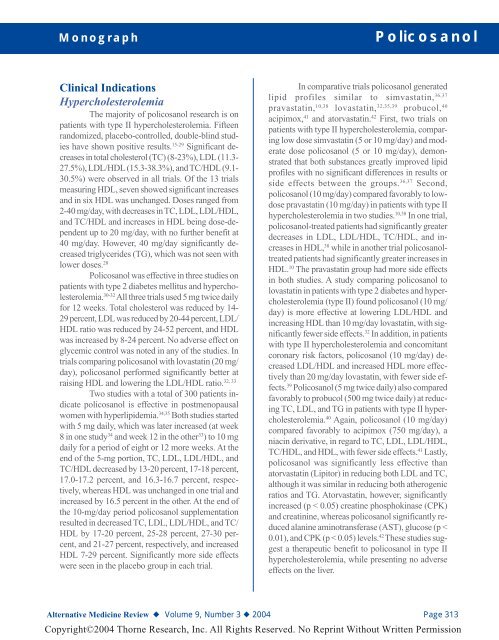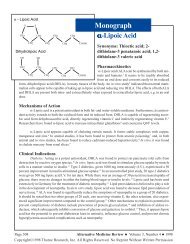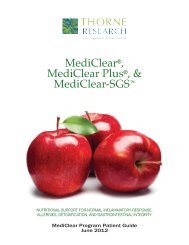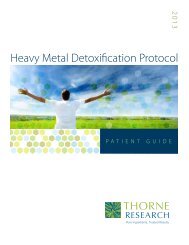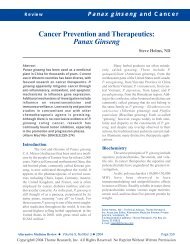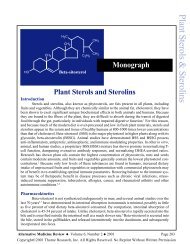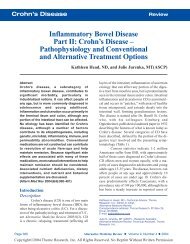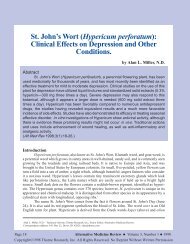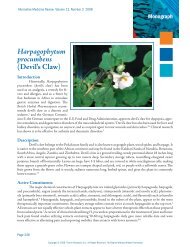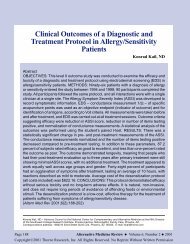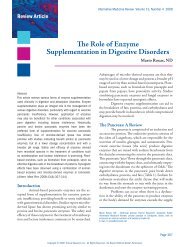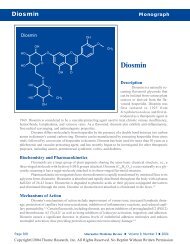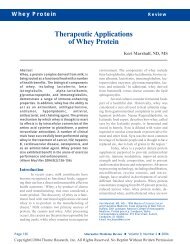Monograph - Thorne Research
Monograph - Thorne Research
Monograph - Thorne Research
Create successful ePaper yourself
Turn your PDF publications into a flip-book with our unique Google optimized e-Paper software.
<strong>Monograph</strong><br />
Policosanol<br />
Clinical Indications<br />
Hypercholesterolemia<br />
The majority of policosanol research is on<br />
patients with type II hypercholesterolemia. Fifteen<br />
randomized, placebo-controlled, double-blind studies<br />
have shown positive results. 15-29 Significant decreases<br />
in total cholesterol (TC) (8-23%), LDL (11.3-<br />
27.5%), LDL/HDL (15.3-38.3%), and TC/HDL (9.1-<br />
30.5%) were observed in all trials. Of the 13 trials<br />
measuring HDL, seven showed significant increases<br />
and in six HDL was unchanged. Doses ranged from<br />
2-40 mg/day, with decreases in TC, LDL, LDL/HDL,<br />
and TC/HDL and increases in HDL being dose-dependent<br />
up to 20 mg/day, with no further benefit at<br />
40 mg/day. However, 40 mg/day significantly decreased<br />
triglycerides (TG), which was not seen with<br />
lower doses. 28<br />
Policosanol was effective in three studies on<br />
patients with type 2 diabetes mellitus and hypercholesterolemia.<br />
30-32 All three trials used 5 mg twice daily<br />
for 12 weeks. Total cholesterol was reduced by 14-<br />
29 percent, LDL was reduced by 20-44 percent, LDL/<br />
HDL ratio was reduced by 24-52 percent, and HDL<br />
was increased by 8-24 percent. No adverse effect on<br />
glycemic control was noted in any of the studies. In<br />
trials comparing policosanol with lovastatin (20 mg/<br />
day), policosanol performed significantly better at<br />
32, 33<br />
raising HDL and lowering the LDL/HDL ratio.<br />
Two studies with a total of 300 patients indicate<br />
policosanol is effective in postmenopausal<br />
women with hyperlipidemia. 34,35 Both studies started<br />
with 5 mg daily, which was later increased (at week<br />
8 in one study 34 and week 12 in the other 33 ) to 10 mg<br />
daily for a period of eight or 12 more weeks. At the<br />
end of the 5-mg portion, TC, LDL, LDL/HDL, and<br />
TC/HDL decreased by 13-20 percent, 17-18 percent,<br />
17.0-17.2 percent, and 16.3-16.7 percent, respectively,<br />
whereas HDL was unchanged in one trial and<br />
increased by 16.5 percent in the other. At the end of<br />
the 10-mg/day period policosanol supplementation<br />
resulted in decreased TC, LDL, LDL/HDL, and TC/<br />
HDL by 17-20 percent, 25-28 percent, 27-30 percent,<br />
and 21-27 percent, respectively, and increased<br />
HDL 7-29 percent. Significantly more side effects<br />
were seen in the placebo group in each trial.<br />
In comparative trials policosanol generated<br />
lipid profiles similar to simvastatin, 36,37<br />
pravastatin, 10,38 lovastatin, 32,35,39 probucol, 40<br />
acipimox, 41 and atorvastatin. 42 First, two trials on<br />
patients with type II hypercholesterolemia, comparing<br />
low dose simvastatin (5 or 10 mg/day) and moderate<br />
dose policosanol (5 or 10 mg/day), demonstrated<br />
that both substances greatly improved lipid<br />
profiles with no significant differences in results or<br />
side effects between the groups. 36,37 Second,<br />
policosanol (10 mg/day) compared favorably to lowdose<br />
pravastatin (10 mg/day) in patients with type II<br />
hypercholesterolemia in two studies. 10,38 In one trial,<br />
policosanol-treated patients had significantly greater<br />
decreases in LDL, LDL/HDL, TC/HDL, and increases<br />
in HDL, 38 while in another trial policosanoltreated<br />
patients had significantly greater increases in<br />
HDL. 10 The pravastatin group had more side effects<br />
in both studies. A study comparing policosanol to<br />
lovastatin in patients with type 2 diabetes and hypercholesterolemia<br />
(type II) found policosanol (10 mg/<br />
day) is more effective at lowering LDL/HDL and<br />
increasing HDL than 10 mg/day lovastatin, with significantly<br />
fewer side effects. 32 In addition, in patients<br />
with type II hypercholesterolemia and concomitant<br />
coronary risk factors, policosanol (10 mg/day) decreased<br />
LDL/HDL and increased HDL more effectively<br />
than 20 mg/day lovastatin, with fewer side effects.<br />
39 Policosanol (5 mg twice daily) also compared<br />
favorably to probucol (500 mg twice daily) at reducing<br />
TC, LDL, and TG in patients with type II hypercholesterolemia.<br />
40 Again, policosanol (10 mg/day)<br />
compared favorably to acipimox (750 mg/day), a<br />
niacin derivative, in regard to TC, LDL, LDL/HDL,<br />
TC/HDL, and HDL, with fewer side effects. 41 Lastly,<br />
policosanol was significantly less effective than<br />
atorvastatin (Lipitor) in reducing both LDL and TC,<br />
although it was similar in reducing both atherogenic<br />
ratios and TG. Atorvastatin, however, significantly<br />
increased (p < 0.05) creatine phosphokinase (CPK)<br />
and creatinine, whereas policosanol significantly reduced<br />
alanine aminotransferase (AST), glucose (p <<br />
0.01), and CPK (p < 0.05) levels. 42 These studies suggest<br />
a therapeutic benefit to policosanol in type II<br />
hypercholesterolemia, while presenting no adverse<br />
effects on the liver.<br />
Alternative Medicine Review ◆ Volume 9, Number 3 ◆ 2004 Page 313<br />
Copyright©2004 <strong>Thorne</strong> <strong>Research</strong>, Inc. All Rights Reserved. No Reprint Without Written Permission


